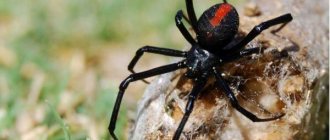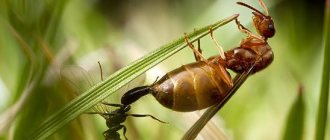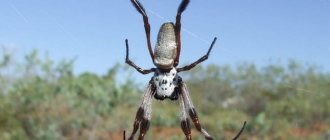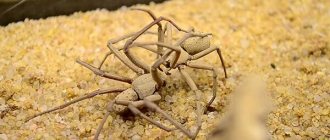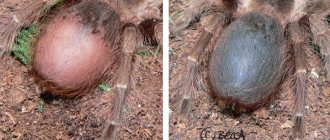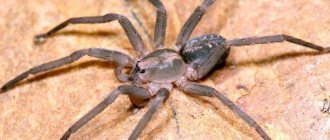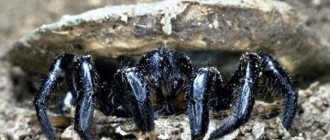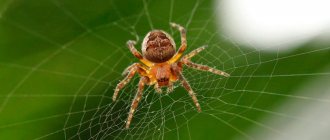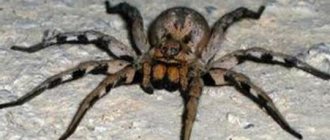Arachnophobia is the most common phobia in the world. Indeed, for many people, spiders are a complete nightmare.
The goliath tarantula is considered one of the most terrible species of arthropods. After all, its size is comparable to the parameters of a human face.
Theraphosa blond is the largest spider in the world. However, there is no point in being afraid of the goliath tarantula. This type of arachnid almost never attacks humans.
It feeds primarily on mice, snakes and small birds. But the spider bites people and large animals only for the purpose of protection.
Jumping spiders
The huge family of jumping spiders includes more than 610 genera and 5,800 species, which are found everywhere except in cold latitudes
Jumping spiders got their name from their ability to jump far and high. Recently, the mechanism of their jumping has been studied more thoroughly. It turned out that the problem was a well-developed internal hydraulic system. Spiders can expand their limbs by changing the blood pressure in them, and this allows them to make a very strong push. Jumping spiders usually hunt during the day. They do not weave hunting webs, they sneak up, suddenly jump on prey and bite it, paralyzing it with poison.
Interestingly, before jumping, spiders insure themselves with a silk thread, attaching it to the place from which they are going to jump. It can be high to fall.
Jumping spiders have good vision, they can see up to 40 cm away, and the viewing angle of 8 eyes is almost 360 degrees. Unlike other spiders, they climb glass easily thanks to their small hairs and claws. In case of danger, they will prefer to hide; if this does not work out, they take a typical defensive pose: they raise their front paws and begin to quickly wave them, trying to scare the aggressor.
Should you be afraid of tarantulas?
The bite of this large spider is fatal to small rodents. There are cases where domestic cats have died from a tarantula bite. It is logical to assume that they can cause significant damage to the child’s health.
Females are especially aggressive in the active phase of motherhood. But sometimes it is also impossible to predict the spider’s reaction to completely harmless and familiar actions. Therefore, it is not recommended to take it with your hands. Before a tarantula , you need to buy not only a terrarium, but also long tweezers for various manipulations with the spider.
The toxicity of tarantula venom depends on its variety. For an adult, a tarantula bite is no more dangerous than a wasp sting. The same burning pain and slight swelling. But in particularly difficult cases, the consequences of toxic poisoning can manifest themselves in the form of loss of consciousness, fever, vomiting and even delirium.
In addition to bites, the fibers that cover the spider's body pose a potential threat. A stressed tarantula quickly pulls out fibers from the surface of its abdomen with its paws. The video clearly demonstrates how this happens.
When toxins come into contact with the skin, they can cause burns and allergic reactions. Contact of the villi with the eyes causes an active burning sensation that does not go away for several hours and sometimes days.
Sometimes this even caused vision impairment forever. If a potential threat to health does not frighten the future owner, and the exotic appearance of the tarantula does not alarm, then you can safely get such a pet.
Peacock spider (Maratus volans)
The title of the most beautiful spider in the world also belongs to the jumping horse, it is called the Peacock Spider (Maratus volans)
The peacock is a small, brightly colored spider. The length of its body does not exceed 5 mm. Males are very bright, females are pale, unpresentable and very aggressive towards the opposite sex.
During the mating season, the spider selects a bride and begins to dance in front of her, raising its abdomen and spreading its third pair of legs. He tries, moves energetically and hopes for reciprocity. If he can arouse the interest of a representative of the fairer sex, he may survive. Otherwise, the female will catch and eat the annoying suitor.
Population and species status
Photo: Male tarantula spider
Today, the tarantula spider is considered a fairly common arachnid. They are distributed almost everywhere. The exception is Antarctica, as well as some regions of Europe. There are several species that are not as common as others, but they are not included in the list of flora and fauna listed in the Red Book.
There are no special events or programs related to spider conservation in any country in the world. However, where spiders are quite common, information work is being carried out with the population regarding behavior when encountering a poisonous arthropod, since it can pose a serious danger.
The tarantula spider is quite common in various countries of the world as a pet. Breeders and lovers of exotic animals often choose it. It is not whimsical in terms of living conditions, is not rare or expensive, and does not require any special nutrition. To get such an extraordinary pet, you need to carefully study the conditions of its maintenance and feeding habits.
The tarantula spider has a rather specific, bright appearance and impressive size. It is distributed in almost all corners of the globe. When meeting him, do not forget that the spider is poisonous. Breeders of exotic animals are advised to familiarize themselves with first aid measures for insect bites.
Tags:
- Opisthothelae
- Panarthropoda
- Theraphosoidea
- Big spiders
- Giant spiders
- Bilaterally symmetrical
- Animals of Australia
- Animals of Australia and Oceania
- Animals of Eurasia
- Animals of Spain
- Animals of Italy
- Animals of the forest
- Animals starting with the letter P
- Animals of New Zealand
- Semi-desert animals
- Desert Animals
- Animals of deserts and semi-deserts
- Animals of North America
- Animals of the Subtropical Zone of the Southern Hemisphere
- Animals of the Subequatorial Belt of the Southern Hemisphere
- Rainforest Animals
- Rainforest Animals
- Animals of the Tropical Zone of the Northern Hemisphere
- Animals of the Tropical Zone of the Southern Hemisphere
- Animals of the Temperate Zone of the Southern Hemisphere
- Animals of South America
- Shedding
- Mygalomorph spiders
- Dangerous spiders
- Spiders
- Tarantula spiders
- Protostomes
- The largest spiders in the world
- The most dangerous spiders
- The most terrible spiders
- Cheliceraceae
- Arthropods
- Eukaryotes
- Eumetazoans
- Poisonous spiders
Mirror spider (Thwaitesia argentiopunctata)
Under a microscope, you can see how the reflective scales on the abdomen pulsate along with the spider's heartbeat
An unusual and very cute spider with sparkles on its abdomen is distributed throughout Australia. It is easy to recognize thanks to the reflective silver spots on its abdomen, but it is difficult to notice. During the day, the miniature spider hides, and at night it builds webs on suitable trees.
Eight-spotted crab spider
It is not clear why this spider was called 8-spotted (Octomaculatus from Latin octo - “eight” and maculatus - “spotted”)
The eight-spotted crab spider was described by Carl Ludwig Koch in 1845, but this rare species has still not been sufficiently studied. Found on the islands of Indonesia. In appearance, it is a slightly flattened yellow or orange spider with noticeable black markings on the cephalothorax and abdomen. The largest known was 0.4 cm long. Bright coloring is needed for camouflage. He spends most of his time on flowers, waiting for unsuspecting bees to fly in to collect nectar and fall right into his paws.
Ultramarine tarantula (Poecilotheria metallica)
Like other tarantulas, Poecilotherium metalica is a fairly large spider, the body can reach a length of 7 cm, and the paw span is 21 cm.
The ultramarine tarantula is endemic to the Indian state of Andhra Pradesh, where its habitat is only 100 square kilometers. km and is highly fragmented as a result of human agricultural activities. The beautiful blue spider was first described in 1899, then unseen by scientists and was considered extinct until it was rediscovered in 2001.
In nature, ultramarine tarantulas live in groups on old trees, adults in the crowns, and young spiders at the foot or in burrows under the roots. They feed mainly on insects. They hunt at night. In cases of very close cohabitation, cannibalism is observed.
Pecilotheria metallica is a very rare and desirable spider among keepers, even despite its complex temperament and poisonous bite. It is considered the most toxic of all tarantulas, the venom causes pain and muscle spasms that can recur for two to three weeks.
Tarantula spider at home
These spiders live in many homes, as they are completely unpretentious and can be bred at home. To prevent spiders from eating one by one, they must be kept alone. You should also follow some rules when keeping a tarantula at home:
- Terrarium. If you decide to get a arboreal spider, then a terrarium with a height of at least thirty-five centimeters will suit it; you will need to place something similar on a tree in it, it can be a large snag. A layer of soil or coconut substrate must be poured onto the bottom. For spiders that live in burrows, you need a long terrarium. A coconut substrate, the thickness of which is at least ten centimeters, is placed at the bottom of such a terrarium. If the spider is young, then the bedding needs to be changed after each molt. If a burrow spider lives in a terrarium, then it needs to create something like a burrow. And also housing for the spider must be provided with a ventilated lid.
- The temperature in the terrarium where the tarantula lives should not be less than twenty-five degrees; for this you need to install a thermal mat or an infrared heater. If the temperature changes sharply, the domestic tarantula may not survive.
- Air humidity should be high, since our pets are from the tropics. It must be at least 80%; to achieve this, it is necessary to periodically spray the substrate in the terrarium with warm water. You only need to spray one corner of the spider’s home and only after the substrate has completely dried.
- Feeding of tarantula spiders. Young spiders need to be fed crickets, fruit flies and cockroaches. You can also give bloodworms and mealworms. Adult spiders need to be fed once or twice a week. Marbled cockroaches, crickets, bloodworms and worms are suitable for them and can also be fed to newborn mice. Food should be given half as much as the spider itself.
King of Spiders - Tarantula Spider _Spiders_
Watch this video on YouTube
Flower crab spiders
Spiders that live on flowers are usually brightly colored, while those that live on bark or on the ground are gray or brownish with a pattern of spots.
In the fall, flower spiders are primarily found on goldenrod and milkweed flowers, so they are also called goldenrod crab spiders ("crab" for their ability to walk sideways forward and backward). Males are very small, at best they grow up to 4 mm, females are slightly larger - up to 10 mm.
The family Thomisidae contains about 175 genera and over 2,100 species, many of which are also known as flower spiders or crab spiders
The enormous color variety of these spiders is due to their ability to change color depending on their environment or the prey they eat. This skill is called active camouflage and provides small defenseless spiders with ideal protection. The color change is not immediate and may take up to 25 days. The flower spider is poisonous and nimble, but does not pose a threat to humans.
Individuals of some species, such as Misumena vatia and Thomisus spectabilis, are able to change color to blend in with the flower on which they are sitting.
Male flower spiders can travel great distances in search of a lady, but females are mostly motionless. They choose one flower on which to settle, sleep, eat and wait for their chosen one. After mating, they guard their nests until the cubs hatch, and then they die.
Habitat of tarantula spiders
Tarantulas can be found all over the globe except Antarctica. They live in African countries, in South America, Oceania and Australia and are also found in Europe, but much less frequently than in other countries. Their European ranges are limited to Spain, Portugal and southern Italy.
In the wild, tree spiders live on bushes and trees, and can also live in shelters that are located at ground level and in burrows. In addition, during development, their lifestyle may change: larvae that live in burrows eventually move to the ground. Some of the tarantulas give their preference to tropical and equatorial forests and semi-deserts.
Tarantulas that live in burrows dig them out on their own, after which they strengthen the burrows with arachnids. Tree bird catchers make special tubes from spider webs. Regardless of their mode of existence, all spiders move very little and make some movements only in cases of great need or danger.
Chilean rose tarantula (Grammostola rosea)
There are two color variations of the species: pink and red Chilean tarantula
The Chilean pink tarantula is one of the most common house spiders. You cannot catch it in the wild; it is protected by UNESCO, but this is usually not necessary; the pink tarantula reproduces very well in captivity. He owes his popularity to his calm temperament, easy care, low price and attractive appearance. The life expectancy of the Chilean rose tarantula is 15-20 years.
The Chilean tarantula is medium-sized, the main color is brown, pink in places, the whole body is covered with light hairs. In nature, he digs deep holes and spends most of his life in them, but in the terrarium he even drags the substrate occasionally and leads a terrestrial lifestyle. It has difficulty moving on smooth glass surfaces due to poorly developed scopulae.
Residence of tarantulas
Experts identify more than 700 varieties of these spiders. But the main types of tarantulas are distinguished according to their places of residence. The conditions of its life in the terrarium depend on what species the spider belongs to.
Terrestrial tarantulas are most often found in the tropical forests of South America and Asia, but they can sometimes be found in hot European countries. These spiders can dig holes in moist soil, entwining them with webs. This feature should be taken into account when organizing a terrarium for such tarantulas.
Burrowing tarantulas prefer the humid climate of Australia and New Zealand or arid Africa. They choose abandoned burrows of small rodents as housing or dig shelters themselves. They leave their home extremely rarely and only at night. For this reason, this particular tarantula is a particularly valuable photographic trophy, since it is very difficult to take a photo.
When going out to hunt or mate, the rest of the time burrowing tarantulas feel great in their shelter. This species is of little interest for keeping at home, since it will not be possible to observe it regularly.
But if the choice falls on it, then the substrate, most often crushed coconut bark, should be poured in such a layer that the domestic tarantula can build a fairly deep burrow. And it should be fed at night so as not to disturb the natural biorhythms of the arthropod.
In Asia and America, arboreal tarantulas choose moist forests to live. African tree spiders thrive in trees in dry areas. It is worth mentioning that only adult individuals settle in trees, while young people lead a terrestrial lifestyle.
When organizing a terrarium for spiders of this species, in addition to a small layer of substrate, you need to add various branches or snags to it. Such conditions can be realized in a vertical terrarium, the width of which is 2 times the size of the spider.
Caribena versicolor
Young spiders are bright blue. As they grow (after a series of moults), they acquire the beautiful color of an adult, as in the photo
One of the most beautiful tarantula spiders. Found naturally in Guadeloupe and Martinique. It settles high in the crowns of trees, where it weaves tunnel-like nests, often of bizarre shape. He usually goes hunting at sunset. Runs quite fast.
Caribena Versicolor is very popular among keepers. It is unpretentious in terms of maintenance, beautiful and grows quickly, has no stinging hairs, is a little shy and not aggressive. Its bite is comparable to that of a wasp.
Interesting facts about tarantula spiders
- Tarantula spiders lack a sense of affection, therefore, it is too bold to think that the spider knows you as its owner and loves you. It is you who know and love him.
- It is impossible to accustom and train a tarantula spider, and also to be absolutely sure of its safety and non-aggressiveness. Even the calmest spiders sometimes bite their owners.
- Female tarantulas are always more expensive than male tarantulas.
- You should not buy a large spider, since you will not be able to be sure that it is not an old individual, but simply a large one. And, it is likely that such a large spider will turn out to be a decrepit old man and will die after its next molt.
- If you want to buy a cheaper spider, take babies that have survived 1-2 molts, however, in this case, it will be impossible to guess their gender in advance.
- The terrarium with the spider should be closed with a tight-fitting lid. If you have a child in the house, lock the terrarium to avoid an accident.
- Spiders are long-living creatures with proper care, so you must understand that this pet is in your home for more than just one day. Are you ready for such a responsibility that will last for even a year?
- Spiders are representatives of a separate class of spiders, and calling them insects is not very correct. Insects have 6 legs, and spiders have 8.
- Spiders do not have ear-shaped hearing organs, but they use tiny hairs on their legs to pinpoint the source of sound.
- If insects have 2 eyes, then tarantulas can have from 2 to 12. Although, in Nature there are absolutely blind spiders that live in caves, and species of spiders that see the world the same way as you and I.
- Spiders detect odors using special hairs on their legs.
Video about tarantula spiders:
Today we talked about tarantula spiders. We were able to learn about the peculiarities of their character and behavior, as well as how and what to feed them, what conditions they need to create in a terrarium for comfortable living, how to breed spiders, and what diseases of your tarantula you may encounter in practice. We hope that our publication will help you decide on the type of spider to choose, and if you have already made your choice in favor of a tarantula spider, you will be able to care for it, taking into account the recommendations of this article.
If you have a tarantula spider living in your house, we will be grateful if you share with us photographs of it and a description of the features of caring for it. Or perhaps you even have some interesting story about your spider? Leave your comments and join our VKontakte group...
We are waiting for your feedback and comments, join our VKontakte group!
Nephila clavipes
The name clavipes was given to the species by Carl Linnaeus in 1767, it comes from the Latin. clava - “thick stick”; and pes - “foot”, “paw”
Next on the list is the Nephila Clavipes spider, with a bright pattern on its abdomen and colorful long legs. It is also known as the golden silk spider. Found in wooded areas of South and North America.
Females of the species Nephila clavips differ noticeably from males in size. The span of their legs reaches 12 cm with a body length of 4 cm. Males are 5 times smaller and 70 times lighter. By studying the DNA of nephiles, scientists found that females gradually increased in size during the process of evolution, while males remained the same as before in the Paleozoic.
The web of an adult female can reach 2 meters in diameter, not counting the anchor threads up to 3 meters long that secure the web between the trees. It is strong enough to hold a small snake, bird or bat. The yellow pigment in Nephila clavips silk gives the web a golden sheen, which is especially visible in the sun.
Nephiles often suffer from spiders of the genus Argyrodes, which steal food from them, and a dozen small parasites can even survive the orb weaver. He will have to leave his old networks and weave new ones.
www.zoo-ekzo.ru – Exotic animals
Distribution
Tarantulas inhabit all continents except Antarctica. The range includes the entirety of Africa, South America, Australia and Oceania. Tarantula spiders are rare in Europe and their range includes the southern half of Italy, Spain and Portugal. They are found as moisture-loving species that live in the crowns of equatorial forests, for example Avicularia versicolor, and drought-resistant semi-desert species, for example Chromatopelma cyaneopubescens.
Behavior
Tarantulas are obligate (strict) predators. Contrary to the name, their digestive system is not designed to constantly feed on meat (poultry). The main diet of tarantula spiders consists of insects or smaller spiders. Spiders are quite omnivorous and can eat a variety of food: flies, cockroaches, bloodworms, frogs, small rodents, birds, fish and much more. Tarantulas ambush prey, rather than using webs to make traps and homes.
Based on their behavior, tarantulas are also informally divided into arboreal, terrestrial and burrowing. It is worth noting that they often change their behavior patterns throughout their lives; if the larvae behave like burrowers, then the adults can spend most of their time on the surface, which is typical for terrestrial and semi-arboreal species. Burrowing spiders dig shelters in the ground, using webs to strengthen the soil; arboreal ones weave tubes from cobwebs. In most cases, spiders are active only when it is clearly necessary. Even hungry spiders can sit completely motionless for a long time, stalking their prey in ambush. Well-fed spiders tend to be even less active: adult female tarantulas often do not leave their hiding places for months.
All species of tarantulas are poisonous to one degree or another; if we are talking about non-poisonous species, then this implies a relatively low degree of toxicity of the poison. A tarantula bite is not fatal to a healthy adult. Most often it is absolutely safe; the bite of some species is painful, but no more than a bee sting. But there are a few species whose bite can cause more significant problems (acute pain, fever, delirium, muscle cramps, etc.). There are no confirmed cases of death as a result of a tarantula bite, however, amateur spider breeders have noted cases of cats dying from bites of their pets. In light of this, some tarantula spiders should be considered deadly for small children or people who have a hypersensitivity to this poison - an allergy to the poison. When biting, poison is not injected in all cases; a “dry” bite often occurs. In addition, even dangerous species most often do not behave aggressively and allow themselves to be touched or crawl onto the palm of their own hands, without even thinking about biting the owner. Hobbyists most often keep species that are absolutely safe for humans.
In addition to poison, protective poisonous hairs, which many species of spiders comb from the abdomen, can serve as a source of irritation. Spiders comb hairs out of stress (in captivity), but in nature, in case of possible danger or for the purpose of self-defense, spiders also weave hairs into webs, thereby protecting their nest. If hairs get on the skin, eyes, or lungs, an allergic reaction may occur: itching, pain in the eyes, suffocation, general weakness. Symptoms usually disappear after a few hours. Amateur spider breeders note that hairs are most developed in terrestrial and semi-arboreal species, slightly less so in burrowing species, and are practically absent in a number of arboreal species. Tree spiders do not shake off protective hairs from their abdomen, but use them only upon direct contact. For people who are not allergic to tarantula hairs (and, as practice shows, the absolute majority are), they are absolutely harmless.
Reproduction
Males reach sexual maturity earlier than females. Signs of adult males of most species are “bulbs” (special containers located on the pedipalps) and tibial hooks on the front legs. Sexually mature males weave a sperm web onto which they secrete seminal fluid and fill the cymbium with this fluid.
In captivity, spiders are given a so-called “wintering place.” So, in the jargon of breeders, they call keeping spiders at a slightly lower temperature. Breeders note that wintering is a necessary condition for the reproduction of a number of tarantula species.
When a mature male and female meet, they perform a series of "ritual" movements designed to demonstrate that they belong to the same species. During mating, the male holds the female's chelicerae with tibal hooks and, using pedipalps, transfers seminal fluid inside the female. During mating and after mating, a hungry female can be aggressive and eat the male; if mating is successful, the male tries to leave the female as quickly as possible. After a few months, the female lays a cocoon containing from 50 to 2000 eggs, depending on the species. The cocoon is guarded by the female for 6-7 weeks. All this time the female remains near the cocoon and is very aggressive. The female also “hatches” the cocoon: she carries it and turns it over from time to time. Next, the eggs hatch into nymphs, who leave the cocoon after a few days.
The eggs hatch into newborn spiders, which in conventional terminology are called nymphs. In most cases, nymphs do not feed and because of this, nymphs can live together for some time - there is no threat of cannibalism. Next, the nymph molts twice and turns into a larva, that is, an almost full-fledged young spider of the first molt. Accordingly, nymphs are of the first and second stages. Externally, nymphs differ little from larvae. Spiders are called larvae until they reach pre-adulthood.
Tarantulas hold the record for longevity among all terrestrial arthropods. The lifespan of spiders depends significantly on gender. Females live many times longer than males. In most cases, male tarantulas, after reaching sexual maturity, never molt and die within a year (months if they manage to mate with a female), while females can live for many years, or even decades. It is noted that some specimens (for example, representatives of the genus Brachypelma) can live up to 30 years or more.
Otherwise, the lifespan of spiders depends on the temperature of keeping and the abundance of food - by delaying feeding, you can slightly increase life expectancy; in the cold, metabolism also slows down, which contributes to slower development.
Shedding
Molts are key stages in spider development. During molting, spiders shed their old exoskeleton and can increase in size by approximately one and a half times in a matter of hours. All the hard parts of the tarantula increase, including the legs, while at the same time the relatively soft abdomen decreases somewhat; the abdomen grows between molts.
Considering that the lifespan and growth rate of spiders significantly depends on conditions, primarily on temperature and the abundance of food, the age of tarantulas is usually measured not in years, but in molts (written as the letter L and a number). While young tarantulas can molt every month, as they approach adulthood, the period between moults increases. Adult female tarantulas molt approximately once a year. In Russia, when numbering moults, it is not customary to take into account the moults of spider nymphs; in other countries, the numbering may differ slightly.
Spiders usually moult while lying on their back. Sometimes when molting, spiders are unable to extend one or two legs or pedipalps and are forced to discard them. Lost legs are restored over 3-4 subsequent molts.
Between molts, spiders often lose protective hairs from their abdomen. They also tend to refuse food some time before molting; in young spiders - a week before the upcoming molting; in adults - from 1 to 3 months.
Signs of an upcoming molt:
- darkening of the abdomen
- general darkening of the spider
- Brightly colored spiders, such as Chromatopelma cyaneopubescens, also exhibit bluish paws between the fifth and sixth moults.
The skins shed by females during molting have a characteristic imprint of the genital organs (elements of the spermatheca); These skins serve to most accurately determine the sex of early instar spiders.
Captivity
In recent years, it has become fashionable to keep tarantulas at home as exotic pets. Some tarantulas are caught in the wild for these purposes, but most are successfully bred in captivity. Spiders are becoming popular due to their relative unpretentiousness and ease of maintenance, as well as very affordable prices for food and the spiders themselves (especially spider larvae).
Almost all the information about the biology of tarantulas known to us today was obtained as a result of studying those spiders that were kept in captivity, and only a small part of it was obtained from observations directly in their habitats.
When choosing a tarantula, a fairly extensive set of factors are taken into account, including the following:
- Floor. The lifespan of male tarantulas is significantly shorter than that of females, and due to their longer life, females grow noticeably larger (if measured by body size). However, males are slightly brighter in color and have a larger paw span.
- Character. For beginners, you should choose species whose individuals are calm in nature and with low toxicity of the poison; these are primarily tarantulas of the New World.
- Type. Tarantulas are divided into three types: burrowing, terrestrial and arboreal. Each type requires different habitats. For a burrow spider, you need a deep layer of substrate, and for an arboreal spider, something like a stick or a piece of bark.
It is recommended to keep tarantulas in terrariums, the size of which exceeds the size of the tarantula (in terms of leg span) by 2-2.5 times. The use of both too cramped and too spacious terrariums is highly undesirable. Each spider should be kept in a separate container, as the risk of cannibalism is high. An exception can be made only for nymph spiders, as well as for pairs of tarantulas during mating. In most cases, coconut substrate (crushed coconut bark) or expanded vermiculite is used as terrarium soil. A burrowing spider requires a deep layer of substrate, since this type spends most of its time underground, but in this case you will rarely see the spider. There is an alternative option. You can fill the terrarium with a less thick layer of substrate, but you must provide the spider with shelter, for example half a flower pot, but in this case the spider will not feel normal, and because of this, outbursts of aggression are possible due to fear and lack of natural shelter. The arboreal species requires a stick or piece of bark as a shelter. Spiders easily move up glass, for this reason the terrarium must have a lid.
The main species bred to feed spiders are cockroaches of various types (the most famous are the marbled cockroach and the Madagascar hissing cockroach), zoophobas larvae, crickets and mealworms. The possibility of feeding tarantulas frozen meat is often discussed. I personally know people who raised spiders on meat or bloodworms or worms alone. In the absence of any food, as a last resort, you can feed it with low-fat meat (preferably white poultry meat) and always raw. Also, if you don’t have insects on hand, you can give the spider earthworms, maggots or bloodworms. The meat and worms must be sprinkled with calcium, since the spider will not have enough of it with such a diet. The spider is reluctant to consume this kind of food, so it is best to give it the most complete natural food - insects. The body length of the food object should be significantly less than the body length of the spider (from chelicerae to arachnoid warts). If food items of the required size are not available, tarantulas can be fed insect parts. There are some types of insects that not only will not take meat with worms, but will also refuse the usual cockroaches if they crawl on the ground or, moreover, lie motionless. Tree species, for example, prefer flies and crickets, often ignoring cockroaches and other ground-dwelling insects. If you have nothing but cockroaches, you can feed them by throwing the cockroaches into the web, but if the cockroach falls down before the spider notices it, most likely the spider will not pick it up again.
Tarantula spiders, for no apparent reason, can refuse food for a long time, according to confirmed data for a year, and according to unconfirmed data - for 2 years. Such hunger strikes take place without visible harm to the health of spiders.
Tarantulas cannot be trained or tamed in the usual sense of the word. This is neither good nor bad. Any spider will easily climb onto any hand if you push it from behind with the other hand. At the same time, they don’t even understand where they got into. For spiders, the hand is the same substrate. They are too “short-sighted” to understand what hands are. It is not recommended to pick up tarantulas in your hands or squeeze them between your fingers. They themselves should both enter your hand and descend from it. You can only help them by giving them a little push.


